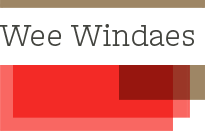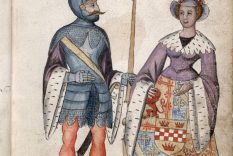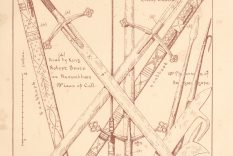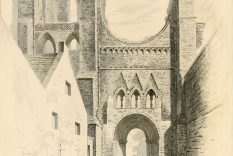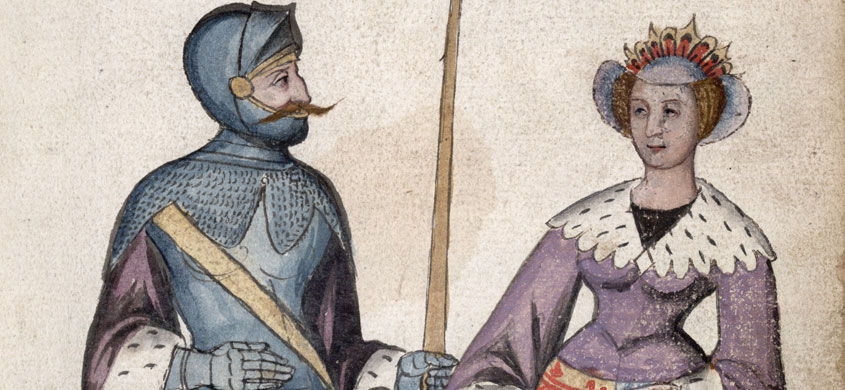
The letter fae the barons o Scotland tae Pope John XXII – noo better kent as the Declaration o Arbroath – was sent fur tae threap the status o Robert the Bruce as the richtfu King o a free-staunin Scotland. It was scrievit in medieval Latin as the lingua franca – the leid o international diplomacy, the kirk, education and record keepin – o western Europe in the 1300s. Though aw clerics would hae been mair or less fluent in it, the Latin abilities o the lay elite are less siccar, and maist Scots o the era wouldnae hae been able tae read or scrieve it.
Lear mair aboot Language and the Declaration o Arbroath
The Declaration was draftit by Abbott Bernard o Arbroath, Bruce’s chancellor and heid o the secretariat, nae doot unner the King’s tentie een. Though we dinnae ken hoo fluently Bruce could read Latin, it’s likely he had at least a warkin kennin.
Ane o the muckle hypotheticals o Scottish history is: in whit language would Bruce hae upsteert his troops afore Bannockburn?
Fur whit it’s worth, The Brus, the byordinar poetic narrative in early Scots fae the later 1300s, has King Robert addressin his nobles, and no the hale airmy. While this micht hae taen place in Norman French, it’s jist as likely that the gey naturalised Bruce would, in fack, hae spak in early Scots, the leid o his Annandale launs.
In 1314, whan the battle taen place, the Northumbrian dialect o Anglo-Saxon spak in Lothian was spreidin oot athort the kintra and was weel on its wey – linguistically forby politically – tae becomin Scots, and a national language o Scotland. Fur exemple, jist ower a century later, in 1424, Scots replaces Latin as the official language recordin the statutes o the Scots Pairlament, and thon kenable shift in its scrievit and official status maun represent shiftin paitterns in whan, and by whom, it was spak ower the generations aforesyne.
Forby early Scots, a wee bit Latin, Middle English and Norman French, it’s mair nor likely that Bruce would also hae spak Gaelic, the language o his mither and o his Carrick hertlauns.
Reflections on the Modern Scots Owersettin
It has come tae be jaloused that the American Declaration o Independence was shapit efter the ensaumple o the Declaration o Arbroath, and, though the evidence fur onie sic connection atween the twa documents is gey shooglie – tae say the least – they are aft thirlt thegither in the public imagination.
As wi its American coonterpairt, the intentions ahint the Declaration o Arbroath and its ongaun status as a “livin document” are aye subjeck tae debate. Certes, though it is gey doutsome that its original signatories ever meant fur it tae be interpretit as sic, the Declaration o Arbroath has lang been celebratit as a pioneerin statement o popular sovereignty, centuries aheid o its time, and it is fur this reason that the document aye hauds ontae its pooer tae this verra day. Efter aw, pittin the pragmatism o historical context tae ae side, whae can honestly threap no tae be moved by the Declaration’s best-kent and maist pooerfu lines anent freedom?
It is in English owersettin (maistlike thon by Sir James Fergusson) – as opposed tae the original Latin – that the Declaration is maist widely kent the day. Tae the owersetters, hooivver, it seemed a gey unco thing that sae mensefu a historic document as the Declaration should no be weel kent in aw the ayebidin leids o its nation – especially Scots, whase early form was likely the maist important lay leid of Scotland in the 1300s, and was siccarly better kent tae Bruce and his men nor was Latin or, indeed, English. Fur monie o them, Scots would hae been their mither tongue, and – tae indulge in anither historical hypothetical – gin a time-traivellin Bruce was somehoo tae turn up in Arbroath in 2020, we doot he’d faur better can read oor Scots version nor either Fergusson’s English or the Latin original.
Tae thon end, in this owersettin, in this 700th anniversary year o the Declaration, we hae ettled at a modern and accessible Scots version, wi a naetheless historical feel, that baith jouks thirldom tae its kenspeckle English equivalent and maks skyrie the mair kittlie fankles o the Latin original forby.
The letter from the barons of Scotland to Pope John XXII – now better known as the Declaration of Arbroath – was sent to assert the status of Robert the Bruce as the rightful King of an independent Scotland. It was written in medieval Latin as the lingua franca – the language of international diplomacy, the church, education and record keeping – of western Europe in the 1300s. Although all clerics would have been more or less fluent in it, the Latin abilities of the lay elite are less certain, and most Scots of the era wouldn’t have been able to read or write it.
Learn more about Language and the Declaration o Arbroath
The Declaration was drafted by Abbott Bernard of Arbroath, Bruce’s chancellor and head of the secretariat, almost certainly under the watchful eyes of the King. Although we’re not sure how fluently Bruce could speak Latin, it’s likely that he had at least a working knowledge.
One of the great hypotheticals of Scottish history is: in what language would Bruce have roused his troops before Bannockburn?
For what it’s worth, The Brus, the magnificent poetic narrative in early Scots from the later 1300s, has King Robert addressing his nobles, and not the whole army. While this might have taken place in Norman French, it’s just as likely that the highly naturalised Bruce would, in fact, have spoken in early Scots, the language of his Annandale lands.
In 1314, when the battle took place, the Northumbrian dialect of Anglo-Saxon spoken in Lothian was spreading out across the country, and was well on its way – linguistically and politically – to becoming Scots, and a national language of Scotland. For example, just over a century later, in 1424, Scots replaces Latin as the official language recording the statutes of the Scottish Parliament, and that notable shift in its written and official status must represent shifting patterns in when, and by whom, it was spoken over preceding generations.
As well as early Scots, some Latin, Middle English and Norman French, it’s highly likely that Bruce would also have spoken Gaelic, the language of his mother and of his Carrick heartlands.
Reflections on the Modern Scots Translation
It has come to be suggested that the American Declaration of Independence was shaped after the example of the Declaration of Arbroath, and, though the evidence for any such connection between the two documents is questionable – to say the least – they have often been linked in the public imagination.
As with its American counterpart, the intentions behind the Declaration of Arbroath and its ongoing status as a ‘living document’ are consistently subject to debate. Certainly, although it is highly doubtable that its original signatories ever meant for it to be interpreted it as such, the Declaration of Arbroath has long been celebrated as a pioneering statement of popular sovereignty, centuries ahead of its time, and it is for this reason that the document retains its power to this very day. After all, putting the pragmatism of historical context to one side, who can honestly claim not to be moved by the Declaration’s best-known and most powerful lines about freedom?
It is in English translation (most likely that by Sir James Fergusson) – as opposed to the original Latin – that the Declaration is most widely known today. To the translators, however, it seemed a strange thing that so meaningful a historic document as the Declaration should not be well known in all the modern languages of its nation – especially Scots, whose early form was likely the most important lay language of Scotland in the 1300s, and was certainly better known to Bruce and his men than was Latin or, indeed, English. For many of them, Scots would have been their mother tongue, and – to indulge in another historical hypothetical – if a time-travelling Bruce was somehow to turn up in Arbroath in 2020, we can be sure that he’d find it far easier to read our Scots version than either Fergusson’s English or the Latin original.
To that end, in this translation, in this 700th anniversary year of the Declaration, we have endeavoured to produce a modern and accessible Scots version, with a nonetheless historical feel, that both avoids slavish adherence to its established English equivalent and brings clarity to some of the trickier opacities of the Latin original.
- Author:
- Barons of Scotland
- Publication Date:
- 2020
- Imprentit:
Arbroath
Excerpt frae the Declaration
Maist Haly Faither, we ken and fae the chronicles and buiks o the auncients we lairn that amang ither faur-kent nations, oor ain, the Scots, has been blisst with braid renoun. Vaigin fae Greater Scythia by wey o the Tyrrhenian Sea and ben the Pillars o Hercules, and bidin in Spain a lang speil amang the maist rochsomefowks, in nae airts could the Scots be dingit doun by onie fowk, nae maitter hou barbarous.
